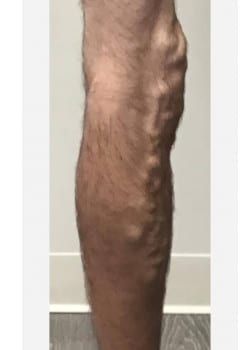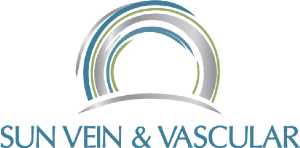Vein Treatments
Varicose Vein Treatments

Dr. Sun offers the following treatments to remove varicose veins. Our team can help you choose which one will work best for you!
Radiofrequency Ablation (RFA)
RFA consists of inserting an FDA-approved catheter (VNUS ClosureFAST ®) into the affected vein. Radiofrequency energy (heat) is then delivered to the vein and seals it shut like EVLA. Once the bad vein is closed, blood is naturally rerouted to healthy veins which improves venous circulation.
Varithena Treatment
Varithena® (polidocanol injectable foam) is an FDA-approved prescription medicine injected into abnormal veins under ultrasound guidance to seal them shut. Some patients receiving Varithena® only need a single treatment. Additional treatment may be required, depending on the number and size of veins to be treated.
VenaSeal Closure System
The VenaSeal™ system is a form of ablation that improves blood flow by closing diseased veins with a medical adhesive (glue). A special catheter system delivers a small amount of specially formulated adhesive to the diseased vein. The adhesive seals the vein, and blood is rerouted through nearby healthy veins. Currently, this procedure is covered by some insurance providers.
Ultrasound-Guided Sclerotherapy
Endovenous chemical ablation (also referred to as ultrasound-guided sclerotherapy) refers to the injection of a special medicine (sclerosant) into abnormal veins to seal them shut. As with other ablation procedures, the treatment is performed under ultrasound guidance to ensure safety and blood flow is naturally redirected to healthy veins.
Microphlebectomy
Microphlebectomy is an outpatient procedure to remove varicose veins through tiny incisions in your skin. This minimally invasive treatment does not require sutures or general anesthesia and can easily be performed in the office with minimal downtime.
Spider Vein Treatments
Spider veins are most commonly treated by sclerotherapy. The treatment involves injecting a sclerosant solution directly into the vein. The goal of treatment is irreversible venous closure followed by absorption of the vein. Venous blood is then redirected from the abnormal varicose vessel to healthy veins.
As a result, leg discomfort and cosmetic appearance improve. Both liquid and foam formulations are used. A liquid injection is used for smaller surface veins. Foam injection has increased potency and thus is used to treat larger veins. In addition, foam can be observed under ultrasound, in real-time, for better precision. Our team will help create a treatment plan that fits your needs!
Restless Leg Syndrome Treatments
We recommend that anyone who suffers from the symptoms of RLS schedule a consultation with our office. During this consultation, we will perform a diagnostic ultrasound assessment. This ultrasound tells us if venous insufficiency is present. If so, we will plan a course of treatment for the varicose veins, which usually includes a combination of laser treatment and sclerotherapy. This treatment will treat the varicose veins and can improve the symptoms of RLS, avoiding the lifelong need to take neurologic medication.
Conservative Measures
Insurance companies often require a trial of conservative therapy, ranging from six to 12 weeks, before we can treat your varicose veins. Conservative measures include graduated compression stockings, exercise, periodic leg elevation, and Unna boots. Medical-grade compression stockings are often prescribed to control the painful symptoms of varicose veins and swelling in the legs. They are also required to aid in healing following vein treatment procedures. A consultation with Dr. Sun is necessary to determine the strength of the stocking needed to control your symptoms. We keep an ample supply in stock for our patients undergoing treatment, eliminating the need for an additional stop at the pharmacy.
Blood Clot Treatments
Diagnosis and Treatment
The veins of the legs are classified anatomically. The “deep” veins are within and below the muscles, and the “superficial” veins are above the muscles. DVT (deep vein thrombosis) is where a thrombus or clot obstructs a vein. It is a serious condition that can lead to disability and even death if the thrombus travels through the bloodstream to the lungs. When this happens, it is called a pulmonary embolus (PE).
Diagnosis of DVT: lower extremity ultrasound exam
Diagnosis of Pulmonary Embolus: CT scan, ventilation/perfusion scan
Treatment
- Anticoagulation with oral or injectable medication (blood thinners). This is the most common treatment.
- Pharmacologic thrombolysis (infusion of drugs directly into the thrombus through a catheter that dissolves the clot)
- Surgical or minimally invasive interventions to physically remove the clot
- Compression stockings (used for small, below-the-knee thrombus)
- Ambulation
- IVC filter (a small mesh filter surgically placed into the vein to prevent the clot from traveling to the lungs) if the patient cannot be on blood thinners

Share On: